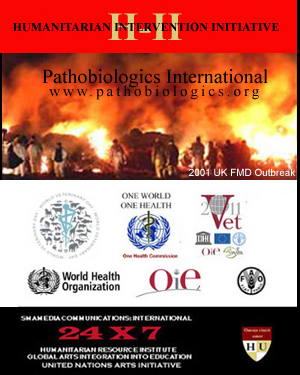20
November 2011
Looking forward to
feedback and progress on this public health infrastructure dicussion,
that was a priority focus during contingency planning for Y2K. At
that time, we had the Center
for Civilian Biodefense Studies, and today, the Center for Biosecurity, still under the
leadership of D.A. Henderson.
---------------------------------------
16
November 2011
From: Stephen M. Apatow
Founder, Director of Research & Development
Humanitarian Resource Institute
Humanitarian University Consortium Graduate Studies
Center for Medicine, Veterinary Medicine & Law
Phone: 203-668-0282
Email: s.m.apatow@humanitarian.net
Internet: www.humanitarian.net
Pathobiologics International
Url: http://www.pathobiologics.org

Biodefense
- We Are Still Not Ready
The New York Times on 26 October 2011 ran the article:
How
Ready Are We for Bioterrorism?
In response, LOWELL
P. WEICKER, former U.S. senator and governor of Connecticut wrote:
Wil
Hylton’s article “How Ready Are We for Bioterrorism?” raised important
concerns about how hard it is to protect the country from naturally
occurring and man-made biological threats. He outlined how the lack of
profitability and the bureaucratic hoops required to get vaccines and
medical countermeasures to market can mean we’re often our own worst
enemy. But he missed an equally important and extremely troubling part
of the equation: cuts to the Centers for Disease Control and Prevention
and to state budgets mean that even when we have medicines and
vaccines, we aren’t in a position to get them to Americans quickly.
Federal support for preparedness has been gutted, dropping 37 percent
since fiscal year 2005, and state and local health departments have cut
an estimated 44,000 workers between 2008 and 2010. After Sept. 11 and
anthrax, we built up biodefense capabilities, but we’re moving
backward. When the next tragedy strikes, we will not be ready. The
price tag for lack of preparedness will be American lives.
This
topic brings me back to the discussion "Preventing
a WMD September 11" (Humanitarian
Resource
Institute Biodefense Legal Resource Center, February
2004):
Today,
the threat of smallpox
as a weapon of mass destruction threatens a significant
percentage
of the global population. In the United States, approximately 25
percent
(70 million) of the population would be excluded from smallpox
vaccination
due to risk factors that include eczema, immunodeficiency, or
pregnancy,
in themselves or in their close contacts. Extended to the global
population
base, approximately 1.5 billion would be at serious risk if smallpox
spread
worldwide due to a bioterrorist incident, in a scenario exponentially
complicated
since vaccination is the key variable for containment and control.
As discussed during
the Future of Biodetection Systems Workshop, [1] sponsored by Los
Alamos in 2006, it is critical that we advance a collaborative One
Health global response to these unmet needs. [2, 3]
Looking
forward to your feedback.
Related
HRI:UNArts One Health News:
- HRI:UNArts - One
World, One Health: World Veterinary Day 2010: World Veterinary
Association, 24 April 2010. Url: www.worldvet.org/node/6267
- HRI:UNArts: One Health Initiative Unites Human and
Veterinary Medicine: Education News (K-12, Higher Education), 24
April 2010. Url: www.educationnews.org/pr_releases/61019.html
- Expanding
Human to Veterinary Biomechanics Applications: Science Informer, 15
April 2005. Url:
www.scienceinformer.com/AgriculturePR/Veterinary-Biomechanics-Applications.htm
- Announcements
2004 (20): International Veterinary Public Health Consortium (IVPHC):
ProMED: International Society for Infectious Diseases, Archive:
20041012.2781, 12 October 2004. Url: http://www.promedmail.org
- International Veterinary
Public Health Consortium: World Veterinary Association, October
2004.
Url: www.worldvet.org/node/463
- Announcements 2003 (08): Humanitarian University
Consortium: ProMED: International Society for Infectious Diseases,
Archive: 20031122.2904, 22 November 2003. Url: www.promedmail.org
- Agricultural Biosecurity: Department of Public
Information (DPI) of the United Nations, 26 January 2002. Url:
www.undpi.org/UN-Topics/Agricultural-Biosecurity.html
References:
1. The Future of Biodetection Systems - Final Workshop
Analysis: The
Future of Biodetection Systems Workshop was held
last year to bring together industry, academia, national labs, and
federal agency personnel in an interactive process, to develop a
roadmap for research and development investment in
biodetection. Sponsored by Los Alamos National
Laboratory, September 26 & 27 2006. -- Overview: BTACC
Pathobiologics International.
Keynote: DNA-based Detection Technologies (Powerpoint):
Stephen M.Apatow, Humanitarian
University Consortium Graduate Studies Center
for Medicine, Veterinary
2. H-II: Stephen Michael Apatow Named Ambassador for
Vet2011:
250th Anniversary of the Global Veterinary Profession: Humanitarian
Resource
Institute, 7 February 2011.
3. HRI:UNArts: Global Comprehensive Health Organization,
One Health Commission Locates to ISU: Humanitarian
Resource
Institute, 3 March 2011. Includes Yale School of Medicine:
Yale Human Animal Health Project – A Center for “One Health” studies
(USA)
|